Management Accounting Report: Costing, Budgeting, and Planning Tools
VerifiedAdded on 2020/10/05
|18
|5183
|402
Report
AI Summary
This report delves into management accounting principles, focusing on the Agmet Company. It begins by defining management accounting, outlining its requirements, and categorizing its types, including cost accounting, inventory management, and job costing systems. The report then analyzes various management accounting reports, such as accounts receivables, inventory management, cost accounting, and budget reports, emphasizing their significance in decision-making. It evaluates the benefits of these systems, highlighting cost control and production efficiency. A critical analysis of how management accounting systems and reports are integrated within a company is also provided. The report further explores absorption and marginal costing methods, including the preparation of income statements and break-even analysis. It discusses the merits and demerits of planning tools, their application in budgeting and forecasting, and compares management accounting systems across different organizations to address financial challenges. Finally, the report concludes with a summary of the benefits and drawbacks of planning tools in resolving financial issues.
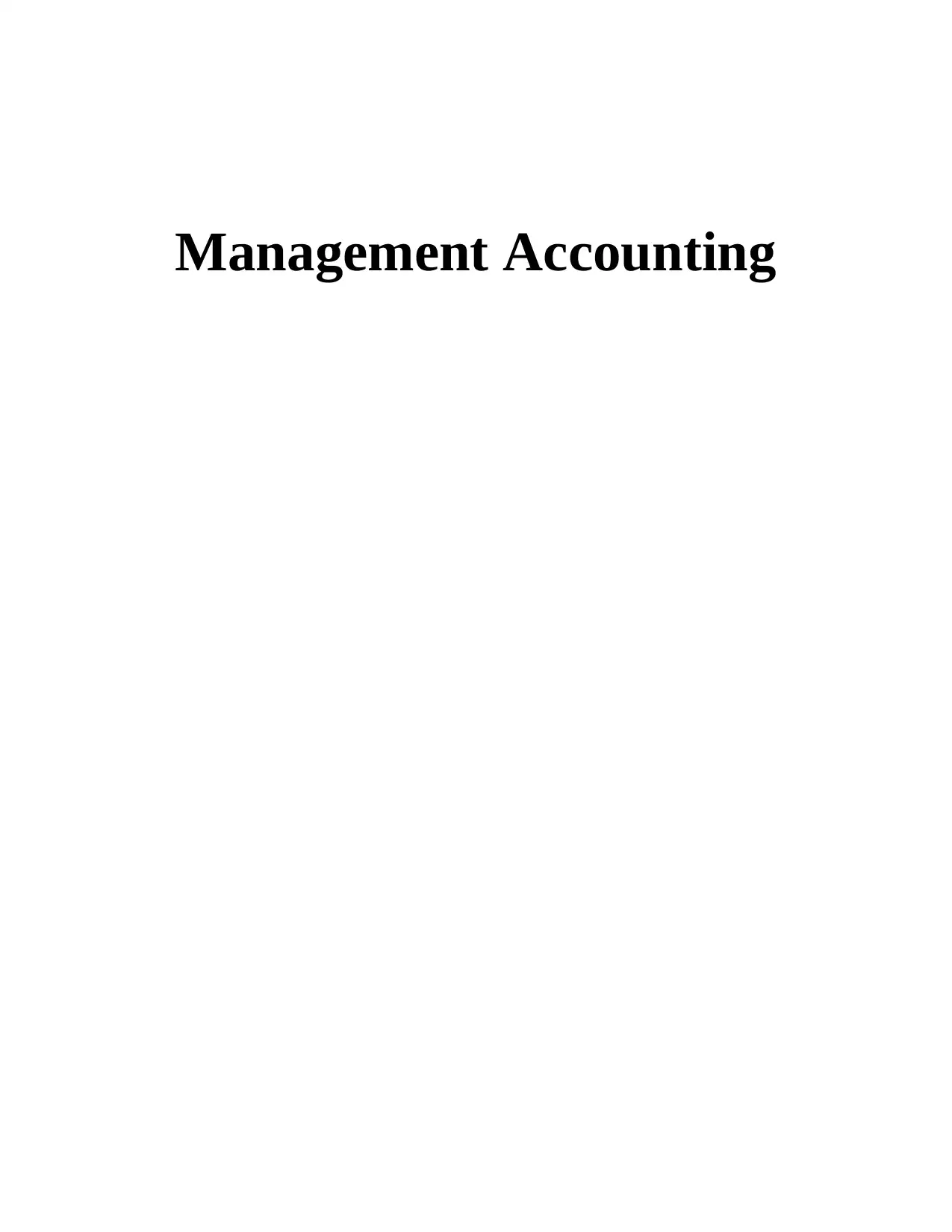
Management Accounting
Paraphrase This Document
Need a fresh take? Get an instant paraphrase of this document with our AI Paraphraser
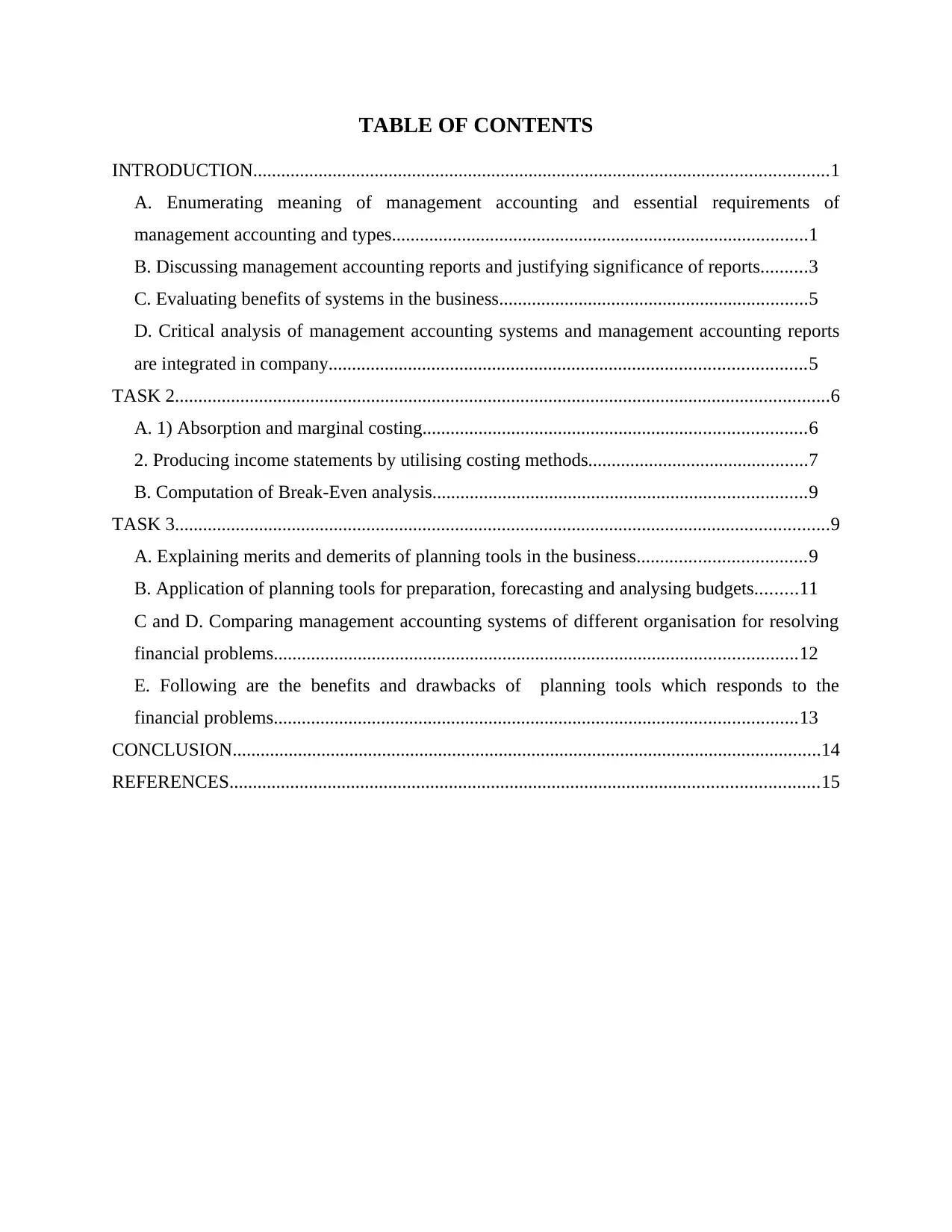
TABLE OF CONTENTS
INTRODUCTION...........................................................................................................................1
A. Enumerating meaning of management accounting and essential requirements of
management accounting and types.........................................................................................1
B. Discussing management accounting reports and justifying significance of reports..........3
C. Evaluating benefits of systems in the business..................................................................5
D. Critical analysis of management accounting systems and management accounting reports
are integrated in company......................................................................................................5
TASK 2............................................................................................................................................6
A. 1) Absorption and marginal costing..................................................................................6
2. Producing income statements by utilising costing methods...............................................7
B. Computation of Break-Even analysis................................................................................9
TASK 3............................................................................................................................................9
A. Explaining merits and demerits of planning tools in the business....................................9
B. Application of planning tools for preparation, forecasting and analysing budgets.........11
C and D. Comparing management accounting systems of different organisation for resolving
financial problems................................................................................................................12
E. Following are the benefits and drawbacks of planning tools which responds to the
financial problems................................................................................................................13
CONCLUSION..............................................................................................................................14
REFERENCES..............................................................................................................................15
INTRODUCTION...........................................................................................................................1
A. Enumerating meaning of management accounting and essential requirements of
management accounting and types.........................................................................................1
B. Discussing management accounting reports and justifying significance of reports..........3
C. Evaluating benefits of systems in the business..................................................................5
D. Critical analysis of management accounting systems and management accounting reports
are integrated in company......................................................................................................5
TASK 2............................................................................................................................................6
A. 1) Absorption and marginal costing..................................................................................6
2. Producing income statements by utilising costing methods...............................................7
B. Computation of Break-Even analysis................................................................................9
TASK 3............................................................................................................................................9
A. Explaining merits and demerits of planning tools in the business....................................9
B. Application of planning tools for preparation, forecasting and analysing budgets.........11
C and D. Comparing management accounting systems of different organisation for resolving
financial problems................................................................................................................12
E. Following are the benefits and drawbacks of planning tools which responds to the
financial problems................................................................................................................13
CONCLUSION..............................................................................................................................14
REFERENCES..............................................................................................................................15
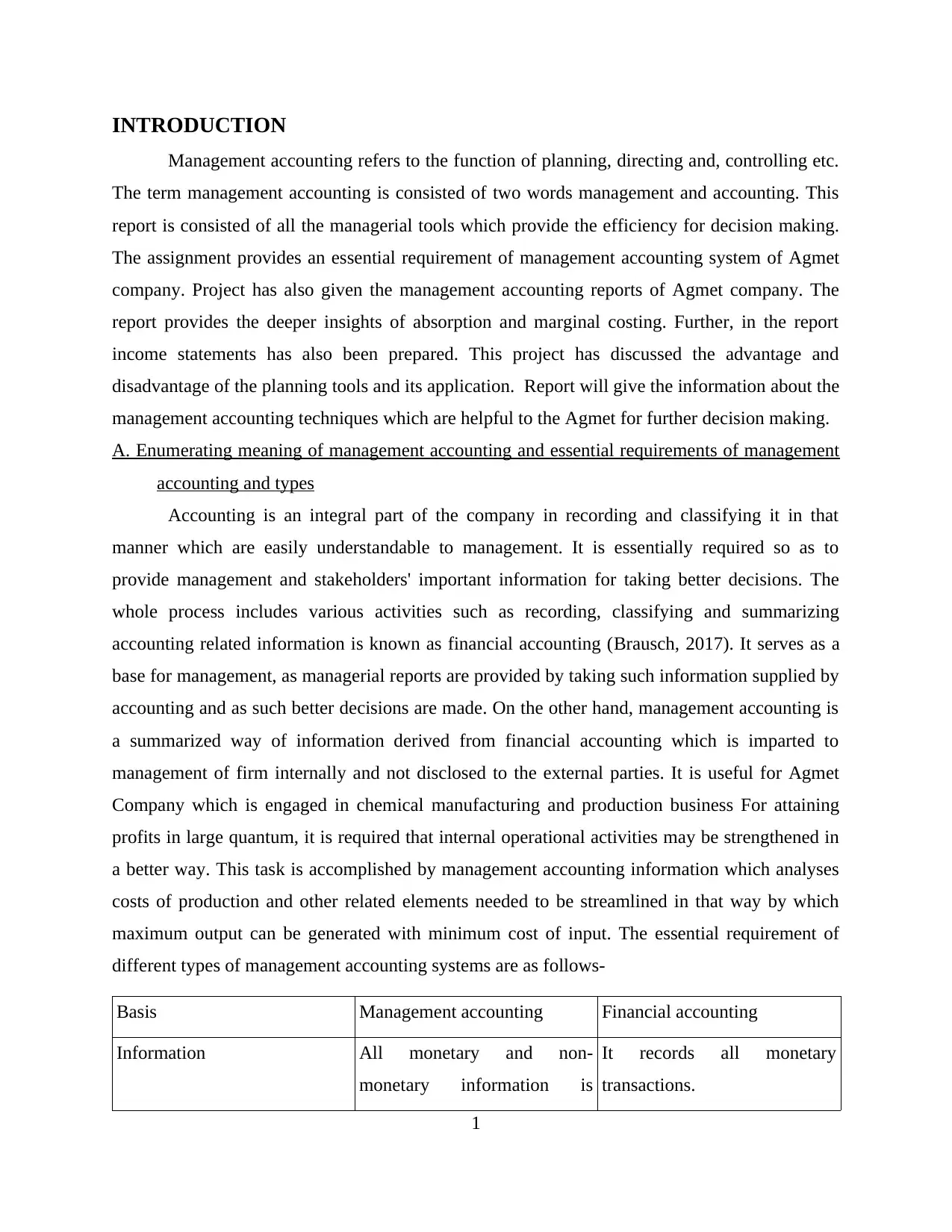
INTRODUCTION
Management accounting refers to the function of planning, directing and, controlling etc.
The term management accounting is consisted of two words management and accounting. This
report is consisted of all the managerial tools which provide the efficiency for decision making.
The assignment provides an essential requirement of management accounting system of Agmet
company. Project has also given the management accounting reports of Agmet company. The
report provides the deeper insights of absorption and marginal costing. Further, in the report
income statements has also been prepared. This project has discussed the advantage and
disadvantage of the planning tools and its application. Report will give the information about the
management accounting techniques which are helpful to the Agmet for further decision making.
A. Enumerating meaning of management accounting and essential requirements of management
accounting and types
Accounting is an integral part of the company in recording and classifying it in that
manner which are easily understandable to management. It is essentially required so as to
provide management and stakeholders' important information for taking better decisions. The
whole process includes various activities such as recording, classifying and summarizing
accounting related information is known as financial accounting (Brausch, 2017). It serves as a
base for management, as managerial reports are provided by taking such information supplied by
accounting and as such better decisions are made. On the other hand, management accounting is
a summarized way of information derived from financial accounting which is imparted to
management of firm internally and not disclosed to the external parties. It is useful for Agmet
Company which is engaged in chemical manufacturing and production business For attaining
profits in large quantum, it is required that internal operational activities may be strengthened in
a better way. This task is accomplished by management accounting information which analyses
costs of production and other related elements needed to be streamlined in that way by which
maximum output can be generated with minimum cost of input. The essential requirement of
different types of management accounting systems are as follows-
Basis Management accounting Financial accounting
Information All monetary and non-
monetary information is
It records all monetary
transactions.
1
Management accounting refers to the function of planning, directing and, controlling etc.
The term management accounting is consisted of two words management and accounting. This
report is consisted of all the managerial tools which provide the efficiency for decision making.
The assignment provides an essential requirement of management accounting system of Agmet
company. Project has also given the management accounting reports of Agmet company. The
report provides the deeper insights of absorption and marginal costing. Further, in the report
income statements has also been prepared. This project has discussed the advantage and
disadvantage of the planning tools and its application. Report will give the information about the
management accounting techniques which are helpful to the Agmet for further decision making.
A. Enumerating meaning of management accounting and essential requirements of management
accounting and types
Accounting is an integral part of the company in recording and classifying it in that
manner which are easily understandable to management. It is essentially required so as to
provide management and stakeholders' important information for taking better decisions. The
whole process includes various activities such as recording, classifying and summarizing
accounting related information is known as financial accounting (Brausch, 2017). It serves as a
base for management, as managerial reports are provided by taking such information supplied by
accounting and as such better decisions are made. On the other hand, management accounting is
a summarized way of information derived from financial accounting which is imparted to
management of firm internally and not disclosed to the external parties. It is useful for Agmet
Company which is engaged in chemical manufacturing and production business For attaining
profits in large quantum, it is required that internal operational activities may be strengthened in
a better way. This task is accomplished by management accounting information which analyses
costs of production and other related elements needed to be streamlined in that way by which
maximum output can be generated with minimum cost of input. The essential requirement of
different types of management accounting systems are as follows-
Basis Management accounting Financial accounting
Information All monetary and non-
monetary information is
It records all monetary
transactions.
1
⊘ This is a preview!⊘
Do you want full access?
Subscribe today to unlock all pages.

Trusted by 1+ million students worldwide
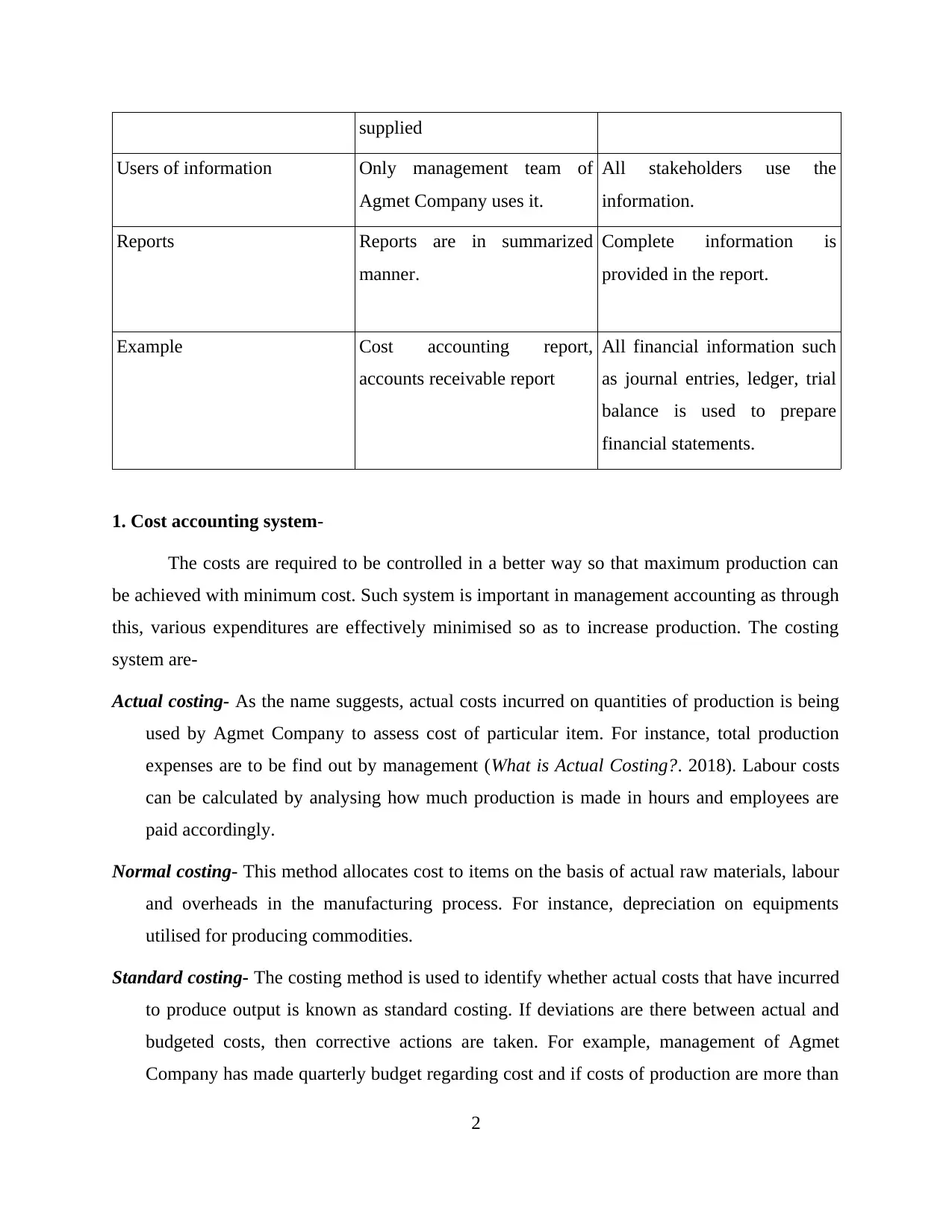
supplied
Users of information Only management team of
Agmet Company uses it.
All stakeholders use the
information.
Reports Reports are in summarized
manner.
Complete information is
provided in the report.
Example Cost accounting report,
accounts receivable report
All financial information such
as journal entries, ledger, trial
balance is used to prepare
financial statements.
1. Cost accounting system-
The costs are required to be controlled in a better way so that maximum production can
be achieved with minimum cost. Such system is important in management accounting as through
this, various expenditures are effectively minimised so as to increase production. The costing
system are-
Actual costing- As the name suggests, actual costs incurred on quantities of production is being
used by Agmet Company to assess cost of particular item. For instance, total production
expenses are to be find out by management (What is Actual Costing?. 2018). Labour costs
can be calculated by analysing how much production is made in hours and employees are
paid accordingly.
Normal costing- This method allocates cost to items on the basis of actual raw materials, labour
and overheads in the manufacturing process. For instance, depreciation on equipments
utilised for producing commodities.
Standard costing- The costing method is used to identify whether actual costs that have incurred
to produce output is known as standard costing. If deviations are there between actual and
budgeted costs, then corrective actions are taken. For example, management of Agmet
Company has made quarterly budget regarding cost and if costs of production are more than
2
Users of information Only management team of
Agmet Company uses it.
All stakeholders use the
information.
Reports Reports are in summarized
manner.
Complete information is
provided in the report.
Example Cost accounting report,
accounts receivable report
All financial information such
as journal entries, ledger, trial
balance is used to prepare
financial statements.
1. Cost accounting system-
The costs are required to be controlled in a better way so that maximum production can
be achieved with minimum cost. Such system is important in management accounting as through
this, various expenditures are effectively minimised so as to increase production. The costing
system are-
Actual costing- As the name suggests, actual costs incurred on quantities of production is being
used by Agmet Company to assess cost of particular item. For instance, total production
expenses are to be find out by management (What is Actual Costing?. 2018). Labour costs
can be calculated by analysing how much production is made in hours and employees are
paid accordingly.
Normal costing- This method allocates cost to items on the basis of actual raw materials, labour
and overheads in the manufacturing process. For instance, depreciation on equipments
utilised for producing commodities.
Standard costing- The costing method is used to identify whether actual costs that have incurred
to produce output is known as standard costing. If deviations are there between actual and
budgeted costs, then corrective actions are taken. For example, management of Agmet
Company has made quarterly budget regarding cost and if costs of production are more than
2
Paraphrase This Document
Need a fresh take? Get an instant paraphrase of this document with our AI Paraphraser
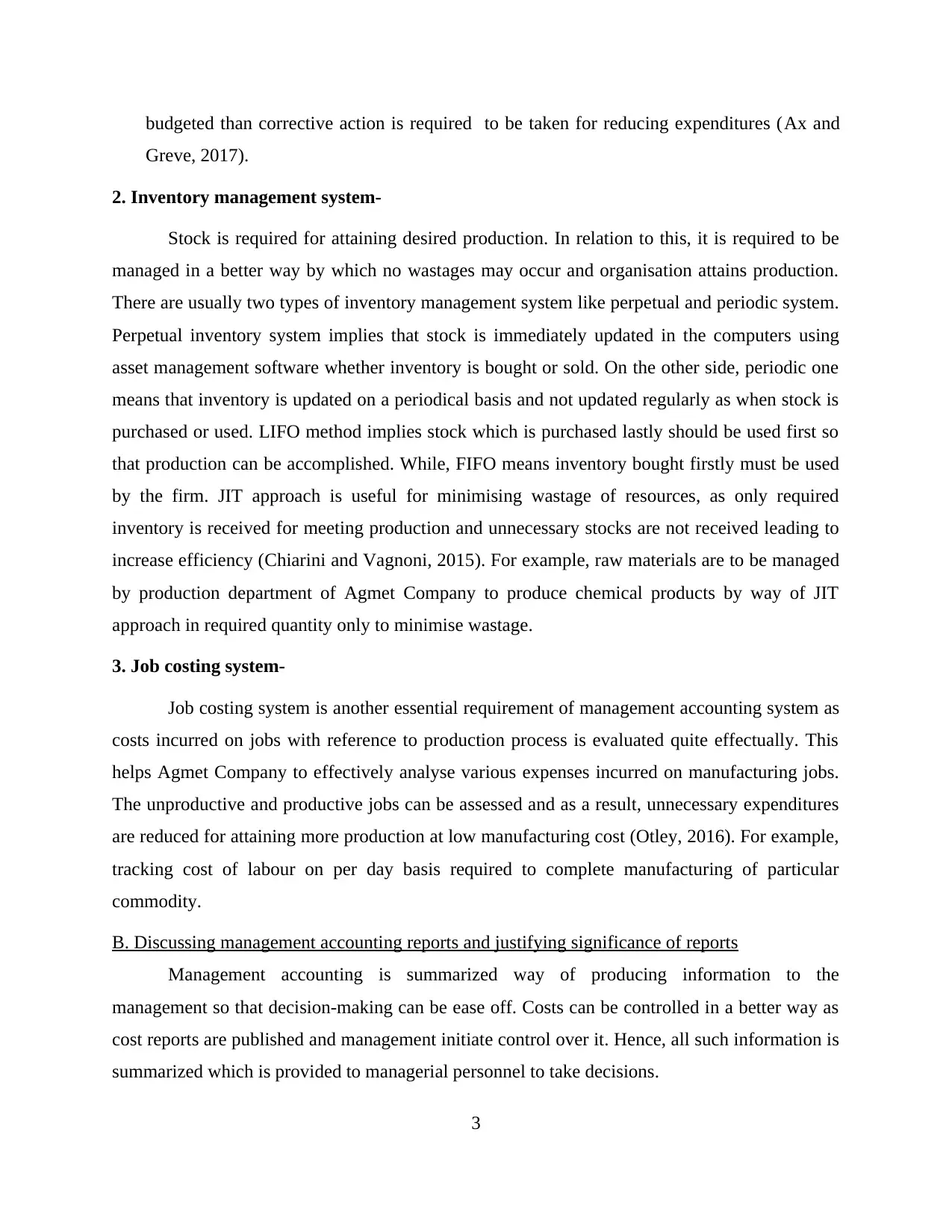
budgeted than corrective action is required to be taken for reducing expenditures (Ax and
Greve, 2017).
2. Inventory management system-
Stock is required for attaining desired production. In relation to this, it is required to be
managed in a better way by which no wastages may occur and organisation attains production.
There are usually two types of inventory management system like perpetual and periodic system.
Perpetual inventory system implies that stock is immediately updated in the computers using
asset management software whether inventory is bought or sold. On the other side, periodic one
means that inventory is updated on a periodical basis and not updated regularly as when stock is
purchased or used. LIFO method implies stock which is purchased lastly should be used first so
that production can be accomplished. While, FIFO means inventory bought firstly must be used
by the firm. JIT approach is useful for minimising wastage of resources, as only required
inventory is received for meeting production and unnecessary stocks are not received leading to
increase efficiency (Chiarini and Vagnoni, 2015). For example, raw materials are to be managed
by production department of Agmet Company to produce chemical products by way of JIT
approach in required quantity only to minimise wastage.
3. Job costing system-
Job costing system is another essential requirement of management accounting system as
costs incurred on jobs with reference to production process is evaluated quite effectually. This
helps Agmet Company to effectively analyse various expenses incurred on manufacturing jobs.
The unproductive and productive jobs can be assessed and as a result, unnecessary expenditures
are reduced for attaining more production at low manufacturing cost (Otley, 2016). For example,
tracking cost of labour on per day basis required to complete manufacturing of particular
commodity.
B. Discussing management accounting reports and justifying significance of reports
Management accounting is summarized way of producing information to the
management so that decision-making can be ease off. Costs can be controlled in a better way as
cost reports are published and management initiate control over it. Hence, all such information is
summarized which is provided to managerial personnel to take decisions.
3
Greve, 2017).
2. Inventory management system-
Stock is required for attaining desired production. In relation to this, it is required to be
managed in a better way by which no wastages may occur and organisation attains production.
There are usually two types of inventory management system like perpetual and periodic system.
Perpetual inventory system implies that stock is immediately updated in the computers using
asset management software whether inventory is bought or sold. On the other side, periodic one
means that inventory is updated on a periodical basis and not updated regularly as when stock is
purchased or used. LIFO method implies stock which is purchased lastly should be used first so
that production can be accomplished. While, FIFO means inventory bought firstly must be used
by the firm. JIT approach is useful for minimising wastage of resources, as only required
inventory is received for meeting production and unnecessary stocks are not received leading to
increase efficiency (Chiarini and Vagnoni, 2015). For example, raw materials are to be managed
by production department of Agmet Company to produce chemical products by way of JIT
approach in required quantity only to minimise wastage.
3. Job costing system-
Job costing system is another essential requirement of management accounting system as
costs incurred on jobs with reference to production process is evaluated quite effectually. This
helps Agmet Company to effectively analyse various expenses incurred on manufacturing jobs.
The unproductive and productive jobs can be assessed and as a result, unnecessary expenditures
are reduced for attaining more production at low manufacturing cost (Otley, 2016). For example,
tracking cost of labour on per day basis required to complete manufacturing of particular
commodity.
B. Discussing management accounting reports and justifying significance of reports
Management accounting is summarized way of producing information to the
management so that decision-making can be ease off. Costs can be controlled in a better way as
cost reports are published and management initiate control over it. Hence, all such information is
summarized which is provided to managerial personnel to take decisions.
3
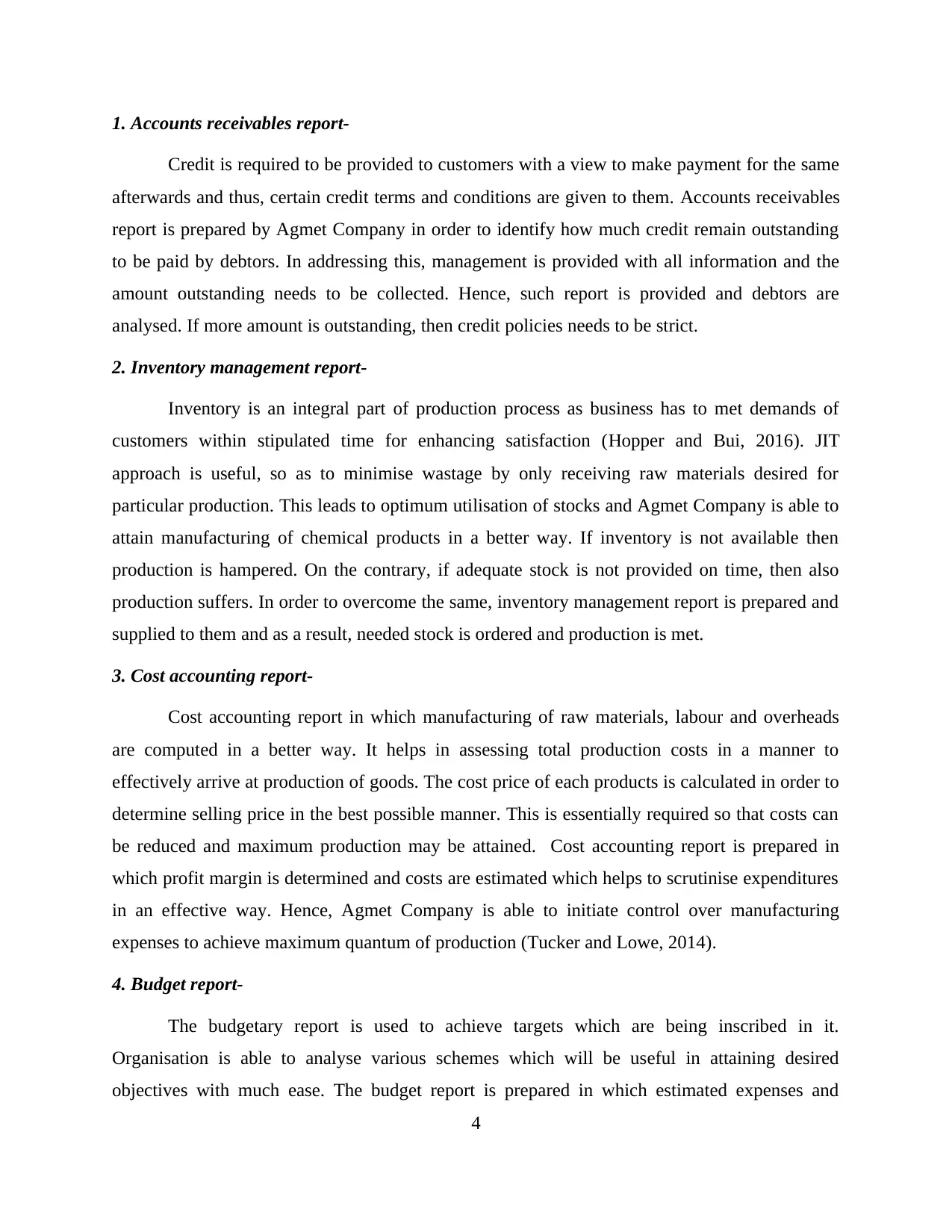
1. Accounts receivables report-
Credit is required to be provided to customers with a view to make payment for the same
afterwards and thus, certain credit terms and conditions are given to them. Accounts receivables
report is prepared by Agmet Company in order to identify how much credit remain outstanding
to be paid by debtors. In addressing this, management is provided with all information and the
amount outstanding needs to be collected. Hence, such report is provided and debtors are
analysed. If more amount is outstanding, then credit policies needs to be strict.
2. Inventory management report-
Inventory is an integral part of production process as business has to met demands of
customers within stipulated time for enhancing satisfaction (Hopper and Bui, 2016). JIT
approach is useful, so as to minimise wastage by only receiving raw materials desired for
particular production. This leads to optimum utilisation of stocks and Agmet Company is able to
attain manufacturing of chemical products in a better way. If inventory is not available then
production is hampered. On the contrary, if adequate stock is not provided on time, then also
production suffers. In order to overcome the same, inventory management report is prepared and
supplied to them and as a result, needed stock is ordered and production is met.
3. Cost accounting report-
Cost accounting report in which manufacturing of raw materials, labour and overheads
are computed in a better way. It helps in assessing total production costs in a manner to
effectively arrive at production of goods. The cost price of each products is calculated in order to
determine selling price in the best possible manner. This is essentially required so that costs can
be reduced and maximum production may be attained. Cost accounting report is prepared in
which profit margin is determined and costs are estimated which helps to scrutinise expenditures
in an effective way. Hence, Agmet Company is able to initiate control over manufacturing
expenses to achieve maximum quantum of production (Tucker and Lowe, 2014).
4. Budget report-
The budgetary report is used to achieve targets which are being inscribed in it.
Organisation is able to analyse various schemes which will be useful in attaining desired
objectives with much ease. The budget report is prepared in which estimated expenses and
4
Credit is required to be provided to customers with a view to make payment for the same
afterwards and thus, certain credit terms and conditions are given to them. Accounts receivables
report is prepared by Agmet Company in order to identify how much credit remain outstanding
to be paid by debtors. In addressing this, management is provided with all information and the
amount outstanding needs to be collected. Hence, such report is provided and debtors are
analysed. If more amount is outstanding, then credit policies needs to be strict.
2. Inventory management report-
Inventory is an integral part of production process as business has to met demands of
customers within stipulated time for enhancing satisfaction (Hopper and Bui, 2016). JIT
approach is useful, so as to minimise wastage by only receiving raw materials desired for
particular production. This leads to optimum utilisation of stocks and Agmet Company is able to
attain manufacturing of chemical products in a better way. If inventory is not available then
production is hampered. On the contrary, if adequate stock is not provided on time, then also
production suffers. In order to overcome the same, inventory management report is prepared and
supplied to them and as a result, needed stock is ordered and production is met.
3. Cost accounting report-
Cost accounting report in which manufacturing of raw materials, labour and overheads
are computed in a better way. It helps in assessing total production costs in a manner to
effectively arrive at production of goods. The cost price of each products is calculated in order to
determine selling price in the best possible manner. This is essentially required so that costs can
be reduced and maximum production may be attained. Cost accounting report is prepared in
which profit margin is determined and costs are estimated which helps to scrutinise expenditures
in an effective way. Hence, Agmet Company is able to initiate control over manufacturing
expenses to achieve maximum quantum of production (Tucker and Lowe, 2014).
4. Budget report-
The budgetary report is used to achieve targets which are being inscribed in it.
Organisation is able to analyse various schemes which will be useful in attaining desired
objectives with much ease. The budget report is prepared in which estimated expenses and
4
⊘ This is a preview!⊘
Do you want full access?
Subscribe today to unlock all pages.

Trusted by 1+ million students worldwide
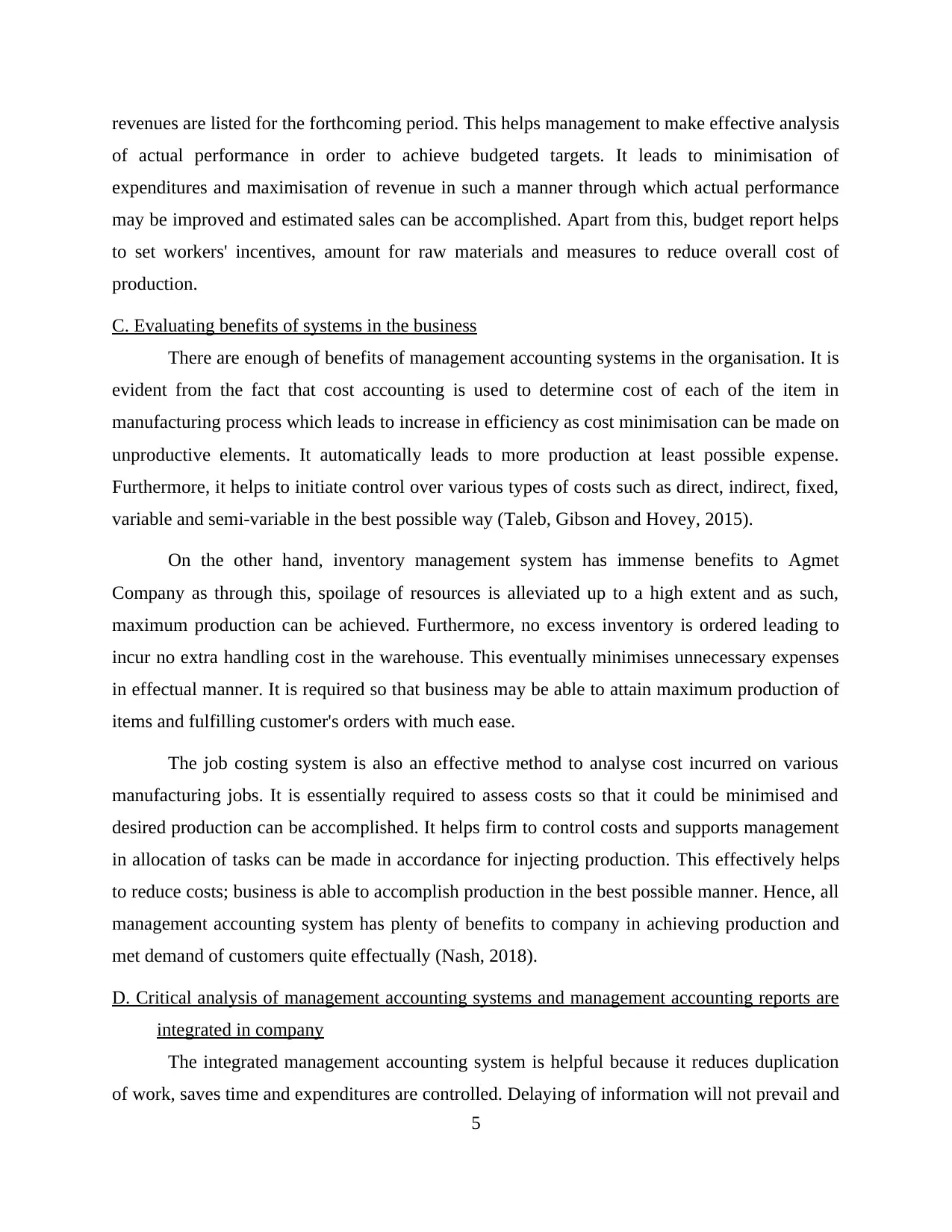
revenues are listed for the forthcoming period. This helps management to make effective analysis
of actual performance in order to achieve budgeted targets. It leads to minimisation of
expenditures and maximisation of revenue in such a manner through which actual performance
may be improved and estimated sales can be accomplished. Apart from this, budget report helps
to set workers' incentives, amount for raw materials and measures to reduce overall cost of
production.
C. Evaluating benefits of systems in the business
There are enough of benefits of management accounting systems in the organisation. It is
evident from the fact that cost accounting is used to determine cost of each of the item in
manufacturing process which leads to increase in efficiency as cost minimisation can be made on
unproductive elements. It automatically leads to more production at least possible expense.
Furthermore, it helps to initiate control over various types of costs such as direct, indirect, fixed,
variable and semi-variable in the best possible way (Taleb, Gibson and Hovey, 2015).
On the other hand, inventory management system has immense benefits to Agmet
Company as through this, spoilage of resources is alleviated up to a high extent and as such,
maximum production can be achieved. Furthermore, no excess inventory is ordered leading to
incur no extra handling cost in the warehouse. This eventually minimises unnecessary expenses
in effectual manner. It is required so that business may be able to attain maximum production of
items and fulfilling customer's orders with much ease.
The job costing system is also an effective method to analyse cost incurred on various
manufacturing jobs. It is essentially required to assess costs so that it could be minimised and
desired production can be accomplished. It helps firm to control costs and supports management
in allocation of tasks can be made in accordance for injecting production. This effectively helps
to reduce costs; business is able to accomplish production in the best possible manner. Hence, all
management accounting system has plenty of benefits to company in achieving production and
met demand of customers quite effectually (Nash, 2018).
D. Critical analysis of management accounting systems and management accounting reports are
integrated in company
The integrated management accounting system is helpful because it reduces duplication
of work, saves time and expenditures are controlled. Delaying of information will not prevail and
5
of actual performance in order to achieve budgeted targets. It leads to minimisation of
expenditures and maximisation of revenue in such a manner through which actual performance
may be improved and estimated sales can be accomplished. Apart from this, budget report helps
to set workers' incentives, amount for raw materials and measures to reduce overall cost of
production.
C. Evaluating benefits of systems in the business
There are enough of benefits of management accounting systems in the organisation. It is
evident from the fact that cost accounting is used to determine cost of each of the item in
manufacturing process which leads to increase in efficiency as cost minimisation can be made on
unproductive elements. It automatically leads to more production at least possible expense.
Furthermore, it helps to initiate control over various types of costs such as direct, indirect, fixed,
variable and semi-variable in the best possible way (Taleb, Gibson and Hovey, 2015).
On the other hand, inventory management system has immense benefits to Agmet
Company as through this, spoilage of resources is alleviated up to a high extent and as such,
maximum production can be achieved. Furthermore, no excess inventory is ordered leading to
incur no extra handling cost in the warehouse. This eventually minimises unnecessary expenses
in effectual manner. It is required so that business may be able to attain maximum production of
items and fulfilling customer's orders with much ease.
The job costing system is also an effective method to analyse cost incurred on various
manufacturing jobs. It is essentially required to assess costs so that it could be minimised and
desired production can be accomplished. It helps firm to control costs and supports management
in allocation of tasks can be made in accordance for injecting production. This effectively helps
to reduce costs; business is able to accomplish production in the best possible manner. Hence, all
management accounting system has plenty of benefits to company in achieving production and
met demand of customers quite effectually (Nash, 2018).
D. Critical analysis of management accounting systems and management accounting reports are
integrated in company
The integrated management accounting system is helpful because it reduces duplication
of work, saves time and expenditures are controlled. Delaying of information will not prevail and
5
Paraphrase This Document
Need a fresh take? Get an instant paraphrase of this document with our AI Paraphraser

management would get complete data on time. Computerized accounting is helpful leading to
quick and efficient work. Accounting procedure is summarized in the best possible manner and
costs are minimised too. Entire head of operational tasks is taken in step-by-step way on cost of
operations, operational job done by labours etc. Hence, management accounting system and
reports are integrated so as to supply adequate information for decision-making to management.
TASK 2
A. 1) Absorption and marginal costing
Marginal costing
Marginal costing is a technique used in decision making to find out the total cost of
production. It is a technique that distinguishes the fixed cost and variable cost. The marginal
costing methods presents the data of where fixed and variable cost are shown separately for
managerial decision making. Marginal costing is not the method of costing like process costing
or job costing. It is a method or technique for analysing the cost information which is to be
provided to management which tries to trigger out an effect on earnings due to change in volume
of input (Chiwamit, Modell and Scapens, 2017). The word marginal involve additional cost
implies in producing an extra unit of output. In marginal costing the valuation of stock is done by
taking the variable cost into account while valuing the finished goods and work in progress. The
profitability of the firm has great impact on cost behaviour. Marginal costing is used by the
manager for taking managerial decisions; it gives the basic understandings of cost data.
Absorption costing
It is a conventional technique of recognizing cost and profit. Absorption costing is a
practice under which all the cost whether fixed or variable are included in the price of products
or services. Therefore, it also known as full costing and total costing. In absorption costing all
the production cost are absorbed by the unit produced. It is a process for collecting the cost
linked with production process and distributing them into individual parts. Under this absorption
costing first of all prime cost is obtained by adding the direct material direct labour and direct
expenses. Then the manufacturing expenses are added to find out the manufacturing cost,
administrative expenses were added to find the cost of production (Van der Stede, 2016). Finally,
selling and distribution expenses were added to obtain total cost. Profit is ascertained either on
6
quick and efficient work. Accounting procedure is summarized in the best possible manner and
costs are minimised too. Entire head of operational tasks is taken in step-by-step way on cost of
operations, operational job done by labours etc. Hence, management accounting system and
reports are integrated so as to supply adequate information for decision-making to management.
TASK 2
A. 1) Absorption and marginal costing
Marginal costing
Marginal costing is a technique used in decision making to find out the total cost of
production. It is a technique that distinguishes the fixed cost and variable cost. The marginal
costing methods presents the data of where fixed and variable cost are shown separately for
managerial decision making. Marginal costing is not the method of costing like process costing
or job costing. It is a method or technique for analysing the cost information which is to be
provided to management which tries to trigger out an effect on earnings due to change in volume
of input (Chiwamit, Modell and Scapens, 2017). The word marginal involve additional cost
implies in producing an extra unit of output. In marginal costing the valuation of stock is done by
taking the variable cost into account while valuing the finished goods and work in progress. The
profitability of the firm has great impact on cost behaviour. Marginal costing is used by the
manager for taking managerial decisions; it gives the basic understandings of cost data.
Absorption costing
It is a conventional technique of recognizing cost and profit. Absorption costing is a
practice under which all the cost whether fixed or variable are included in the price of products
or services. Therefore, it also known as full costing and total costing. In absorption costing all
the production cost are absorbed by the unit produced. It is a process for collecting the cost
linked with production process and distributing them into individual parts. Under this absorption
costing first of all prime cost is obtained by adding the direct material direct labour and direct
expenses. Then the manufacturing expenses are added to find out the manufacturing cost,
administrative expenses were added to find the cost of production (Van der Stede, 2016). Finally,
selling and distribution expenses were added to obtain total cost. Profit is ascertained either on
6
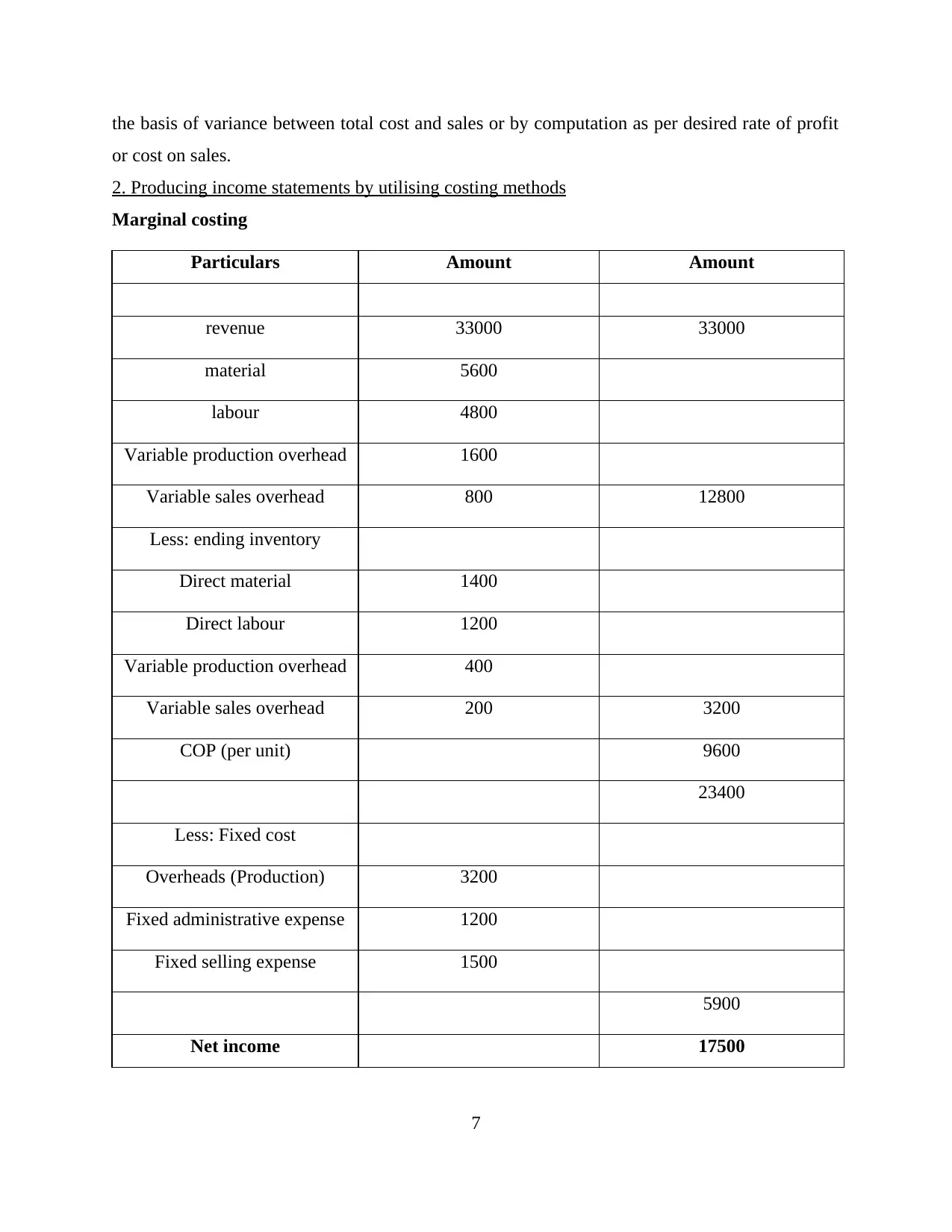
the basis of variance between total cost and sales or by computation as per desired rate of profit
or cost on sales.
2. Producing income statements by utilising costing methods
Marginal costing
Particulars Amount Amount
revenue 33000 33000
material 5600
labour 4800
Variable production overhead 1600
Variable sales overhead 800 12800
Less: ending inventory
Direct material 1400
Direct labour 1200
Variable production overhead 400
Variable sales overhead 200 3200
COP (per unit) 9600
23400
Less: Fixed cost
Overheads (Production) 3200
Fixed administrative expense 1200
Fixed selling expense 1500
5900
Net income 17500
7
or cost on sales.
2. Producing income statements by utilising costing methods
Marginal costing
Particulars Amount Amount
revenue 33000 33000
material 5600
labour 4800
Variable production overhead 1600
Variable sales overhead 800 12800
Less: ending inventory
Direct material 1400
Direct labour 1200
Variable production overhead 400
Variable sales overhead 200 3200
COP (per unit) 9600
23400
Less: Fixed cost
Overheads (Production) 3200
Fixed administrative expense 1200
Fixed selling expense 1500
5900
Net income 17500
7
⊘ This is a preview!⊘
Do you want full access?
Subscribe today to unlock all pages.

Trusted by 1+ million students worldwide
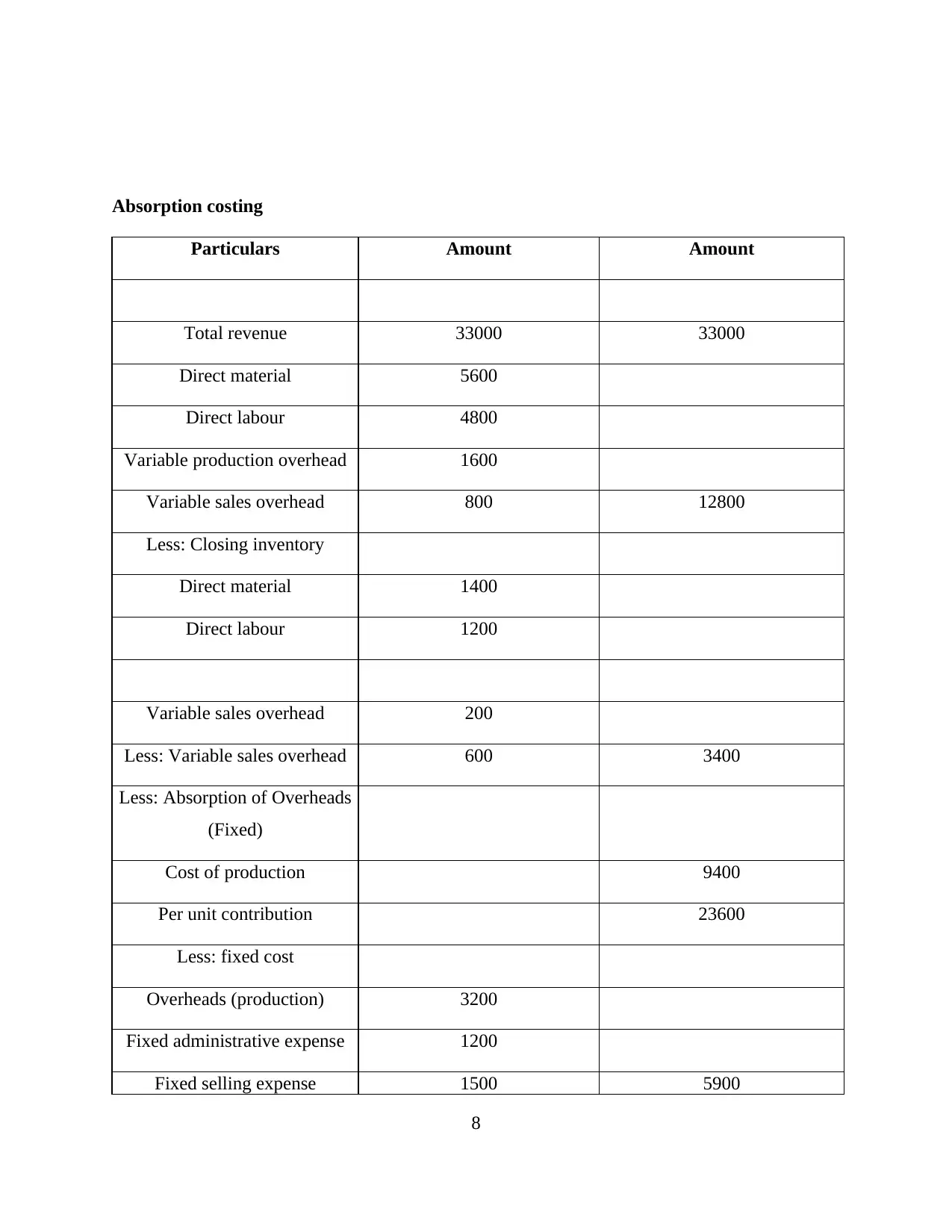
Absorption costing
Particulars Amount Amount
Total revenue 33000 33000
Direct material 5600
Direct labour 4800
Variable production overhead 1600
Variable sales overhead 800 12800
Less: Closing inventory
Direct material 1400
Direct labour 1200
Variable sales overhead 200
Less: Variable sales overhead 600 3400
Less: Absorption of Overheads
(Fixed)
Cost of production 9400
Per unit contribution 23600
Less: fixed cost
Overheads (production) 3200
Fixed administrative expense 1200
Fixed selling expense 1500 5900
8
Particulars Amount Amount
Total revenue 33000 33000
Direct material 5600
Direct labour 4800
Variable production overhead 1600
Variable sales overhead 800 12800
Less: Closing inventory
Direct material 1400
Direct labour 1200
Variable sales overhead 200
Less: Variable sales overhead 600 3400
Less: Absorption of Overheads
(Fixed)
Cost of production 9400
Per unit contribution 23600
Less: fixed cost
Overheads (production) 3200
Fixed administrative expense 1200
Fixed selling expense 1500 5900
8
Paraphrase This Document
Need a fresh take? Get an instant paraphrase of this document with our AI Paraphraser
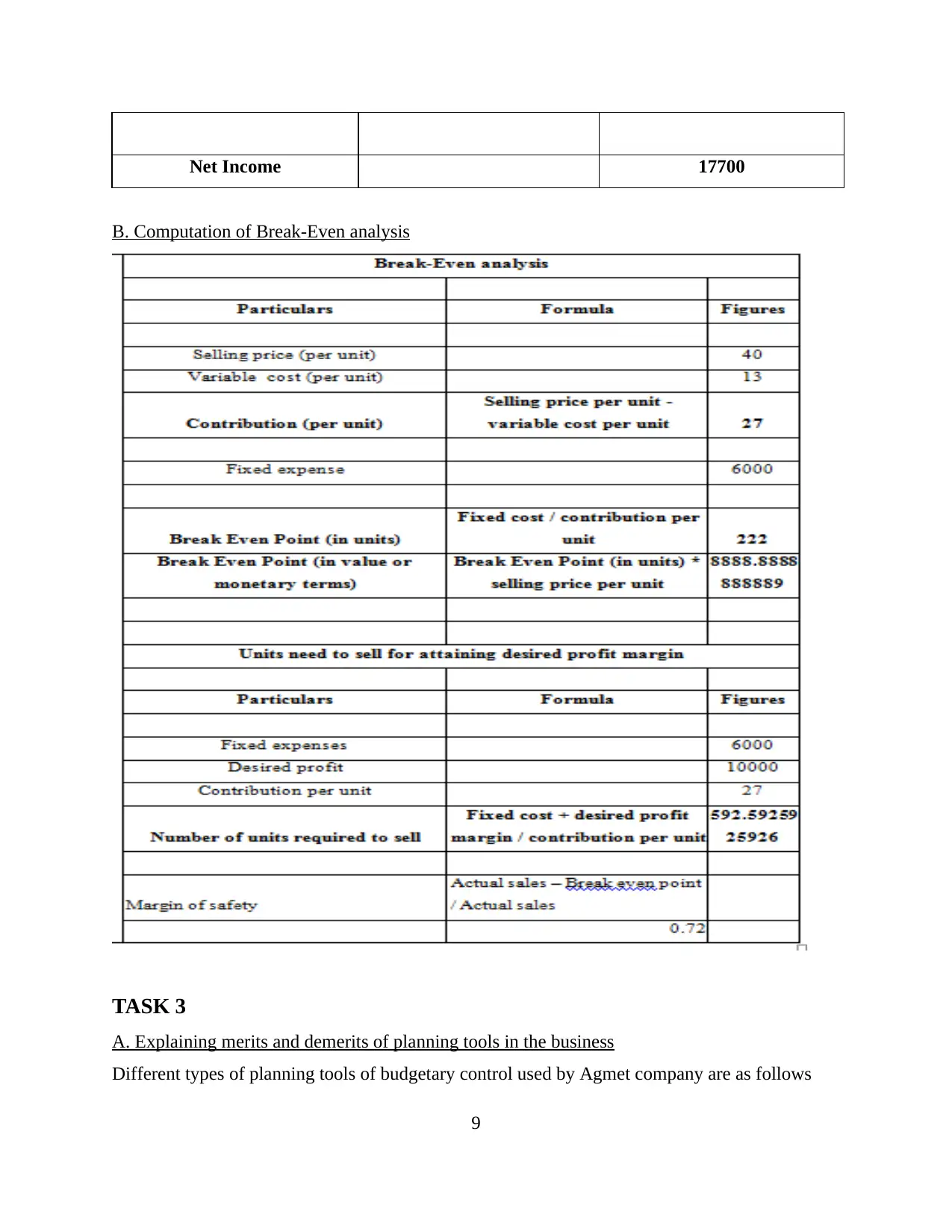
Net Income 17700
B. Computation of Break-Even analysis
TASK 3
A. Explaining merits and demerits of planning tools in the business
Different types of planning tools of budgetary control used by Agmet company are as follows
9
B. Computation of Break-Even analysis
TASK 3
A. Explaining merits and demerits of planning tools in the business
Different types of planning tools of budgetary control used by Agmet company are as follows
9

Zero based budgeting
Zero based budgeting is one of the most important planning tool. It is also known as 'De
nova budgeting '. According to name sound, its starts from zero or clean state. In zero based
budgeting the preparation of budget is done with new analysis, fresh data and new estimates also
it is not linked with figures of previous budget. Zero based budgeting is the traditional way of
budgeting. In this techniques of zero based budgeting each budget is estimated in every time. If
while preparing budget any shortcomings or inefficiencies occurs, They are dropped or deleted.
All the activities in the zero based budgeting is ranked according to their priorities and they are
undertaken accordingly. Activities those have higher priorities are taken first according the
sources available (Hall, 2016). The manager or accountant of the Agmet company begins the
preparation of budget from scratch each time and justifies each dollar depended on strategic
objectives of the company. It will give a fair chance to Agmet to work on inefficiencies and to
find the creative ways to reduce costs. ZBB assures that resources are utilised effectively and
returns are generated from the same.
Advantages of ZBB
ZBB has its one greatest advantage, that it has the efficiency to initiate control over the cost
and thus, better control can be found.
It helps in allocation of resources according to their priorities, which helps in systematic
evaluation of cost related to various operation.
It provides the justification of each activity I.e. And ensures that all the activities executed
are essential for the organization.
Disadvantages of ZBB
Zero based budgeting is the time consuming technique of budgeting because it becomes
very intensive exercise for company to prepare budget every year against incremental
budgeting.
ZBB requires involvement of large number of manpower for making the entire budget Lack of expertise: as it requires the expert-ism in the field of ZBB, it becomes difficult
task for managers to implement the same in company.
Variance analysis
It is very important tool of standard costing. Variance analysis identifies the difference
between the standard level and the actual performance. It shows the major difference between
10
Zero based budgeting is one of the most important planning tool. It is also known as 'De
nova budgeting '. According to name sound, its starts from zero or clean state. In zero based
budgeting the preparation of budget is done with new analysis, fresh data and new estimates also
it is not linked with figures of previous budget. Zero based budgeting is the traditional way of
budgeting. In this techniques of zero based budgeting each budget is estimated in every time. If
while preparing budget any shortcomings or inefficiencies occurs, They are dropped or deleted.
All the activities in the zero based budgeting is ranked according to their priorities and they are
undertaken accordingly. Activities those have higher priorities are taken first according the
sources available (Hall, 2016). The manager or accountant of the Agmet company begins the
preparation of budget from scratch each time and justifies each dollar depended on strategic
objectives of the company. It will give a fair chance to Agmet to work on inefficiencies and to
find the creative ways to reduce costs. ZBB assures that resources are utilised effectively and
returns are generated from the same.
Advantages of ZBB
ZBB has its one greatest advantage, that it has the efficiency to initiate control over the cost
and thus, better control can be found.
It helps in allocation of resources according to their priorities, which helps in systematic
evaluation of cost related to various operation.
It provides the justification of each activity I.e. And ensures that all the activities executed
are essential for the organization.
Disadvantages of ZBB
Zero based budgeting is the time consuming technique of budgeting because it becomes
very intensive exercise for company to prepare budget every year against incremental
budgeting.
ZBB requires involvement of large number of manpower for making the entire budget Lack of expertise: as it requires the expert-ism in the field of ZBB, it becomes difficult
task for managers to implement the same in company.
Variance analysis
It is very important tool of standard costing. Variance analysis identifies the difference
between the standard level and the actual performance. It shows the major difference between
10
⊘ This is a preview!⊘
Do you want full access?
Subscribe today to unlock all pages.

Trusted by 1+ million students worldwide
1 out of 18
Related Documents
Your All-in-One AI-Powered Toolkit for Academic Success.
+13062052269
info@desklib.com
Available 24*7 on WhatsApp / Email
![[object Object]](/_next/static/media/star-bottom.7253800d.svg)
Unlock your academic potential
Copyright © 2020–2025 A2Z Services. All Rights Reserved. Developed and managed by ZUCOL.





